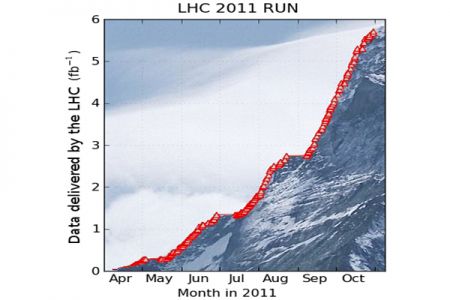
Data are the currency of physics. As data accumulate, measurement uncertainty ranges narrow up to a certain point, increasing the potential for discoveries and making non-observations more stringent, with more far-reaching consequences. In collider physics, the amount of data is measured by the total number of collisions observed, and the rate of those collisions (the luminosity).
In 2011, the LHC produced more collisions than expected at the start of the year, breaking the world record for luminosity in April and then continuing to grow seven-fold. By the end of the proton collision run in November, 240 million protons were colliding each second. Top quarks, once considered rare, were produced at a rate of one pair every two seconds. This provided CMS scientists with enough data to measure known processes with unprecedented precision, improving our understanding of the way protons collide and sharpening theoretical predictions of new phenomena.
One of the most sought-after results in collider physics is proof of supersymmetry (SUSY). This is the idea that matter and forces were unified in the early Universe. Because SUSY may appear in many guises depending on different ways of SUSY can be configured, CMS scientists cast a wide net of search strategies to look for signs of supersymmetric particles. None have been observed so far, and some proposed configurations of SUSY that had been plausible in 2010 are now ruled out. Supersymmetry is still very possible, and so more effort is going into refining the searches to include many of the interesting places that have not yet been covered.
Many models of new phenomena were studied as well, including extra dimensions, substructure within familiar quarks and leptons, new generations of particles, new forces, and even microscopic black holes. In each case, the fact that these phenomena did not appear imposes tighter limits on their existence. For example, curled-up extra dimensions may exist, but if so, they must be curled 2.5 times smaller than was previously open to consideration.
The last four weeks of running were dedicated to collisions of lead ions and physics of an entirely different character. When lead ions collide, so many quarks and gluons are produced that a fluid like the one that existed in the early Universe is thought to form. Data from November 2010 revealed that this fluid is very strongly interacting, absorbs a lot of energy of even the very energetic quarks and gluons, and that it melts various meson states that consist of heavy quarks. It is too soon to say what will be found in 2011's lead-ion dataset, which is about 20 times larger.
The most dramatic revelation of 2011 concerns the Higgs boson, the as-yet unobserved cornerstone of the Standard Model of particle physics. Hundreds of CMS scientists have pored over their data to show that the Standard Model Higgs, if it exists, can only have a mass in the narrow range between 115 and 127 GeV. This could mean that the Higgs is hiding within this range, or that the real Higgs boson is not a Standard Model Higgs but has exotic properties, or that it simply does not exist. LHC scientists anticipate a large enough dataset in 2012 to make a definitive statement. Regardless of the outcome, the stage is set for an exciting year.
— Submitted by Jim Pivarski, originally published in Fermilab Today
- Log in to post comments

